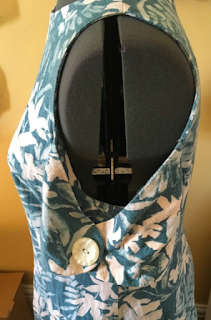In the milling around before going to the Stratford costume warehouse Friday morning, unfortunately I missed heading over to Knox Church and seeing the demos that were happening there. But I did get to meet some people who ended up being on the other bus the next day for fabric shopping, or at other tables Friday night, so that was worthwhile. The costume warehouse was a lot of fun to look at, and then there were two talks on the Friday evening, before a catered dinner.
One talk was by Gillian Whitcombe on taking better pictures. That was very positive, fun and informative. For me to follow her suggestions as they relate to Patternreview, the next step would be to get some kind of extra hardware so I can remotely control a camera, because the whole timer-and-run thing is a drag. The main problem right now is I’ve found my camera, but I put all its chargers and extra batteries *somewhere* when unpacking after the move, so it’s dead until I find them. I’d rather buy a remote for the camera than my phone, I think, since iThings are typically overpriced. But I’ll look into it more.
The second was a demo by the owners of Jalie of some of their patterns, especially their ingenious new V-neck top called "Bobbie." It has a facing acting as a sort of under-vest to keep the V neck close to the body even if you bend over. I think they'd sold out of the ones they brought, but I may buy it later.
I’d show pictures of other attendees but that doesn’t sit well with me to put on this blog, so I’ll leave it to the official PR blog post. Instead, here’s some fabric. The wonderful lace at right I won in a giveaway for entering the most items into contests of anyone at the event… hmm, now I feel like I should finally get around to volunteering to manage one. I'm guessing this happened because I entered lots of things into a couple of stash contests over the years.
I also somehow had posted the most comments on other people’s reviews, so won another of the giveaways for that. Maybe that happened because I have been on for so many years and I used to post on many of the new reviews every day? I was surprised by that but was happy to pick out this grading DVD. I’m very curious to see what grading specs/methods Kathleen Cheetham uses; I know of the Threads article and some of the sizing standards, and I often sew single-size vintage patterns that need to be graded up or down. But I don't know what she does for her Petite Plus sizes.
The rest of the large pieces of fabric were from the shopping trip on Saturday and they’re mostly meant to be used to replace various parts of my summer wardrobe. We’ll see how fast it actually gets sewn up. I’d hoped to get some nice cotton shirtings, and was able to find a couple. I also spied out a lovely handkerchief linen and a raw silk in Ann’s Fabrics in Hamilton. And there’s also a cotton canvas print that I’ve already made up into a skirt, which I’ll review one of these days.
Here’s hoping there are more PR Weekends in Canada soon.















